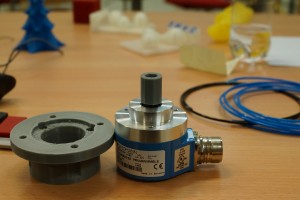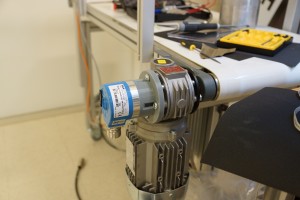The RDI laboratory in Satakunta University of Applied Sciences (SAMK) works in many automation projects but mainly in the area of machine vision, RFID and welfare technology. In these projects, there are constantly situations when some kind of an adapter, casing or other small parts are needed and they must be created out of metal or order from outside of the University. Project engineers in the RDI laboratory read about 3D printers that print plastics and they sounded like a good solution for this problem. So in November 2012 3DTouch printer was ordered to the SAMK RDI laboratory. It arrived in the beginning of December. Since the arrival it has been printing almost 24/7. The printed parts are mostly used in real cases and in student projects, but of course, we also have to print some sample prints.
The 3D camera in the RDI laboratory needs information about movement of the conveyor belt so that imaging can be synchronized with the movement. That is why a rotary encoder is used to get the belt movement data for the 3D camera. Mechanical engineering students tried to design and implement an adapter for the rotary encoder. It was a long process and there were slight design problems.
The adapter didn’t fit between the rotary encoder nor conveyor belt because of the conveyor’s motor. That’s why the rotary encoder was used with a funny tripod DIY’s to get the 3D camera working when needed.
The new 3D Touch gave us an opportunity to print our own design as an adapter for the system. The awareness of the faults made with the metal adapter created the basis for the new design of 3D printable adapter. Of course plastic material also caused some things to take in notice. The adapter should be attached somehow and it had to be durable enough. So designing the adapter was quite straight forward.
The positions of the attach holes and the shape of the conveyer and of the rotary encoder defined very clearly the requirements of the adapter interfaces.


Picture 1 & 2. Two parts of the rotary encoders adapter (gray parts on the left) and the attached rotary encoder with printed adapter (right).
The finished adapter fits perfectly on the conveyor belt and the manufacturing process was a lot faster than the metal one’s. The adapter appears to be very durable, it looks good and it made us to believe that these prints really can last in practice.
